Unless you live on the moon, gravity always forces water to seek the lowest possible point, which is your home’s foundation, basement, or crawl space. Yikes!
Below are a few helpful tips and tools to keep rainwater out of your home.
Rain, Rain, Go Away!
Did you know that when 1″ of rain falls on a 2,000 square foot roof, 1,250 gallons of water pours from the roof? That’s a ton of water. Actually, that’s five tons of water. If the home has four downspouts, there are over 300 gallons of water dumping near the foundation in four different areas.
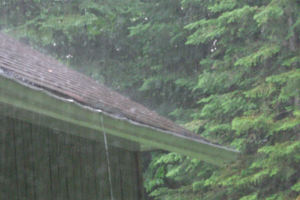
If an area receives only 4″ inches of rain per month, the roof sheds 60,000 gallons of water annually.
With this said, it is critical to control water draining from the roof and divert the water away from the foundation walls to prevent water intrusion. You must take preventive and, in some cases, corrective measures to keep water where it belongs – away from your home. Let’s focus on two strategies: ground water control and roof water control.
Ground Control to Major Tom: Check Your Grading
Surface water refers to water which is introduced to the soil when it rains. If not properly controlled, surface water can make its way into your home’s interior and create damage to the structure, interior surfaces, and homeowner belongings.
Controlling surface water around a home is the most important step to ensuring a proper defense against water intrusion. Regrettably, it’s almost always the most often overlooked strategy.
- Flowers and mulch – Most homeowners look at their landscaping, pretty flowers, and pretty green grass without considering the effects of landscaping on water control. Therefore, when you’re landscaping it’s not just important to see the pretty flowers, but also the slope of the ground and any obstacles to water flowing away from the house. Flowers are great. We love flowers. Heck, everyone loves flowers. But flower beds close to the house can damage the home by holding water directly against the foundation walls.
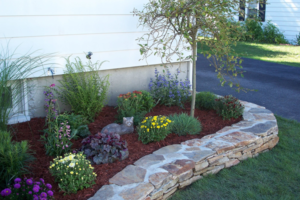
- Landscaping barriers – Installing barriers (retaining walls, landscaping timbers, vertical plastic edging, stones) can exacerbate the problem because barriers don’t just hold flowers and mulch – barriers block drainage. If you must cling to your landscape timbers and edging, make sure downspouts extend beyond the barriers. If your home is in cold climates, don’t direct downspouts onto the driveway and/or sidewalks; snow and freezing rain can make the walking areas unsafe and help to accelerate cracks in the driveway and/or sidewalk.
The Slope of Things to Come
When we mention grading as a defect in a home inspection, the most common question is “Huh?”
“Grading” is simply a term to help describe surface elevation changes when compared to other areas around or near the house. Proper grading is when the grade or slope of the elevation slopes downward and away from the home at a rate of 1″ per foot for the first 6′ and then a continued slope for at least 10′ from the foundation.
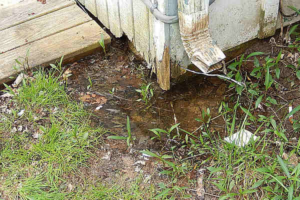
Now, we move to the second most common question: “How do we fix our grading?”
It sounds complicated, but it’s pretty simple – a proper grade allows water to flow away from the home and foundation; an improper grade allows moisture to flow back towards the home and seep into the soil. With improper grade, rain saturates the soil, pressures the foundation, and eventually forces moisture through the foundation and into the basement or crawlspace.
When you’re talking about grade, you may hear our home inspector use the word “swale,” a depression in the grading that is sloped to divert water away from the house. A swale normally is used when the surrounding grade is relatively flat and the sloped depression creates a way for water to flow away without changing the overall grading.
Although there are other strategies for keeping water out (drain tiles, damp proofing coatings, sub-slab drainage pump systems), grading is the easiest and most cost-effective primary defense against water.
Roof Control – Ups and Downs, Strikes and Gutters
What’s the best way to control roof water? Gutters and downspouts are inexpensive and simple ways to keep rainwater from dripping down and accumulating around the foundation and saturating the soil near the foundation. Unfortunately, most homeowners ignore gutters and downspouts, which is why “Missing Downspout Extension” is the sixth most common defect discovered by our inspectors on our Top 10 Issues List.
These downspout splash blocks and downspout extensions are simple and cost-effective ways to divert water away from your home’s foundation. (If you are looking for a 2-pack, we recommend trying these splash blocks).
Gutters must be sloped or pitched to allow water to drain to the downspout area. Too little pitch and there’s not enough flow to remove debris in the gutter; too much pitch isn’t aesthetically pleasing. Generally speaking, an effective gutter slope is roughly ¼ inch drop for every 10′ of gutter. Gutter runs in excess of 30′ should have downspouts installed at each end, pitching the gutter from the center towards each downspout.
Over time, gutters sag as attachment points loosen; this phenomenon allows water to stand in the gutter and concentrate debris in low areas, the weight of which makes gutter attachments even looser and creates more sagging until the gutter hangers or spikes fail completely. Therefore, it is important to clean the gutters regularly and check to make sure that hangers are tight to prevent sagging. Check out this at-home gutter cleaning kit if you want to tackle this task yourself!
Another option is to install gutter guards to keep your gutters free of debris and blockages.
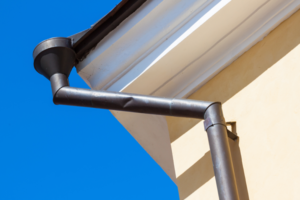
Downspouts collect water from gutters and divert water to the ground. Downspouts must terminate at least 3″ from foundation walls. Problems occur when downspouts don’t direct water properly or where there is blockage directly in front of the downspout. If the turn-piece where the downspout meets the ground (90° or elbow) is missing, the downspout will direct all water straight down the foundation, erode the area, and pond water directly against the foundation.
When Water Avoids Even the Best of Prevention Intentions
Even with the best of water prevention intentions, we’ve all been victims of everlasting April showers that find ways to push water into the basement or crawlspace. Thankfully, most recently constructed homes offer some drainage systems installed on the interior and/or exterior of the home.
What’s the first thing you think of when it’s raining heavily?
“I hope my sump pump is working.” Check your sump pump before the heavy spring and summer rain seasons. Check to make sure that either the vacuum switch or the float triggers the pump and that the ejector line is clear of debris. As with downspouts, sump pump discharge should be away from the foundation, not obstructed and not discharged on sidewalks or driveways.
Unless you live in an area with near zero rain, ground water is almost always present and water may well up under the slab during times of heavy sustained rainfall even when grading is proper and roof water is controlled. We recommend installing a water alarm like this one so you are alerted before there is a surprise flood in your basement. In addition to a sump pump, there are other ways to address ground water, including sub-slab drainage, and directing drainage lines to the exterior.
Controlling ground water in a crawlspace is a similar battle. Add a sump-pump or drainage system and if the crawlspace is dirt, cover the area with a vapor barrier (like this one), which helps to prevents moisture from escaping into the crawlspace area. The vapor barrier won’t stop ground water from flowing into the crawlspace, but it helps to reduce humidity and acts as a deterrent to keep water vapor and dirt smell out of the crawlspace.
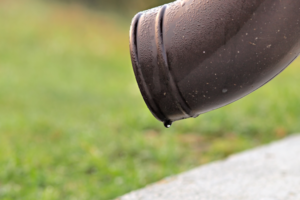
Avoid the Swimming Pool in Your Basement
Although it may be a grand idea to invite guests over to go swimming, you probably didn’t imagine setting up the pool in your basement.
The challenge of water control is just like anything else in life – prevention is the best cure. If you properly employ simple and inexpensive water control methods – grading, gutters, and downspouts – you will greatly reduce your risk of long-term damage caused by water.
If you or have any questions about water control or any inspection service, contact us – we’re pleased and available to guide and assist you.
As an Amazon Associate, we earn from qualifying purchases.
